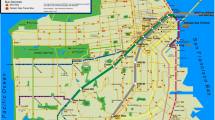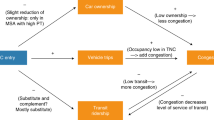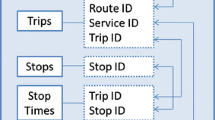Abstract
This research revisits the perennial policy concern that operating subsidies hamper transit efficiency. We argue that the relationship between subsidies and efficiency can be better understood at the regional level and propose improved metrics related to transit efficiency. To begin, we focus on the impact of subsidies on transitsheds rather than transit operators to recast subsidy as a per resident metric, and we average vehicle load in the transitshed as our efficiency metric. Comparing these measures, we discover a surprising trend – transit efficiency is strongly and positively correlated with per resident operating subsidy. To explore this relationship further, we decompose per resident subsidy into federal and non-federal components and generate several new measures to improve modeling of transit efficiency at the transitshed level—subsidy revenue ratio, vehicle ratio, and guideway mile ratio (the latter two of which are scaled by “effective” population). We then apply a linear regression with these new measures on four years of data across the fifteen most populous transitsheds in the United States. Results suggest that operating subsidies promote transit efficiency (with federal subsidies being roughly three times as effective as non-federal subsidies) as long as the subsidies do not unduly outpace revenues. Results also suggest that the vehicle ratio is negatively associated with transit efficiency while the guideway mile ratio is positively associated. These findings offer support for operating subsidies that are reasonably offset by revenues and for targeting capital investments towards fixed guideway infrastructure rather than towards expanding fleet size.







Similar content being viewed by others
Change history
30 December 2023
A Correction to this paper has been published: https://doi.org/10.1007/s11116-023-10458-1
References
Anderson, S.C.: The effect of government ownership and subsidy on performance: Evidence from the bus transit industry. Transp. Res. Part a General 17A, 191–200 (1983). https://doi.org/10.1016/0191-2607(83)90041-9
Barrett A (2022) Documentation for a Datafile
Brons, M., Nijkamp, P., Pels, E., Rietveld, P.: Efficiency of urban public transit: a meta analysis. Transportation 32, 1–21 (2005). https://doi.org/10.1007/s11116-004-0939-4
Cantos, P., Pastor, J.M., Serrano, L.: Productivity, efficiency and technical change in the European railways: a non-parametric approach. Transportation 26, 337–357 (1999)
Cervero, R.: Examining the performance impacts of transit operating subsidies. J. Transp. Eng. 110, 467–480 (1984). https://doi.org/10.1061/(ASCE)0733-947X(1984)110:5(467)
Cowie, J.: The British passenger rail privatisation: conclusions on subsidy and efficiency from the first round of franchises. JTEP 43, 85–104 (2009)
Dajani, J.S., Gilbert, G.: Measuring the performance of transit systems. Transp. Plan. Technol. 4, 97–103 (1978). https://doi.org/10.1080/03081067808717125
Fielding, G.J., Glauthier, R.E., Lave, C.A.: Performance indicators for transit management. Transportation 7, 365–379 (1978). https://doi.org/10.1007/BF00168037
Fitzová, H., Matulová, M., Tomeš, Z.: Determinants of urban public transport efficiency: case study of the Czech Republic. Eur. Transp. Res. Rev. 10, 42 (2018). https://doi.org/10.1186/s12544-018-0311-y
Holmgren, J.: The efficiency of public transport operations—an evaluation using stochastic frontier analysis. Res. Transp. Econ. 39, 50–57 (2013). https://doi.org/10.1016/j.retrec.2012.05.023
Kang, K., Kim, Y.: Relationship between efficiency of bus transit system and subsidy, using a stochastic cost frontier model. Proc. Eastern Asia Soc. Transp. Stud. 11, 1–8 (2017)
Karlaftis, M.G., McCarthy, P.: Operating subsidies and performance in public transit: an empirical study. Transp. Res. Part a Policy Practice 32, 359–375 (1998). https://doi.org/10.1016/S0965-8564(98)00002-0
Karlaftis, M.G., McCarthy, P.S.: Subsidy and public transit performance: A factor analytic approach. Transportation 24, 253–270 (1997)
Lee, M.-T., Yeh, C.-F.: Causal effects between bus revenue vehicle-kilometers and bus ridership. Transp. Res. Part a General 130, 54–64 (2019). https://doi.org/10.1016/j.tra.2019.09.019
Nolan, J.F.: Determinants of productive efficiency in urban transit. Logist. Transp. Rev. 32, 319–342 (1996)
Obeng, K.: Indirect production function and the output effect of public transit subsidies. Transportation 38, 191–214 (2011). https://doi.org/10.1007/s11116-010-9296-7
Obeng, K., Azam, G.: The intended relationship between federal operating subsidy and cost. Public Finance Quarterly 23, 72–94 (1995). https://doi.org/10.1177/109114219502300103
Obeng, K., Sakano, R.: Effects of government regulations and input subsidies on cost efficiency: a decomposition approach. Transp. Policy 91, 95–107 (2020). https://doi.org/10.1016/j.tranpol.2020.03.015
Obeng, K., Sakano, R., Naanwaab, C.: Understanding overall output efficiency in public transit systems: The roles of input regulations, perceived budget and input subsidies. Transp. Res. Part E 89, 133–150 (2016). https://doi.org/10.1016/j.tre.2016.03.001
Office of Budget and Policy (2021) National Transit Database 2021 Policy Manual
Office of Budget and Policy (2017) National Transit Database 2017 Glossary, pp. 1–118
Office of the Secretary. Benefit-Cost Analysis Guidance for Discretionary Grant Programs. Washington, D.C.: U.S. Department of Transportation, Feb. 2021
Pickrell, D.H.: Rising deficits and the uses of transit subsidies in the United States. JTEP 19, 281–298 (1985)
Roy, W., Yvrande-Billon, A.: Ownership, contractual practices and technical efficiency: the case of urban public transport in france. JTEP 41, 257–282 (2007)
Sakano, R., Obeng, K., Azam, G.: Subsidies and inefficiency: stochastic frontier approach. Contemp. Econ. Policy 15, 113–127 (1997). https://doi.org/10.1111/j.1465-7287.1997.tb00483.x
Smerk, G.M.: The urban mass transportation act of 1964: new hope for American cities. Transp. J. 5, 35–40 (1965)
Sujakhu, S., Li, W.: Public transit performance evaluation using data envelopment analysis and possibilities of enhancement. J. Transp. Technol. 10, 89–109 (2020). https://doi.org/10.4236/jtts.2020.102006
Sulek, J., Lind, M.: A systems model for evaluating transit performance. J. Public Transp. 3, 29–47 (2000). https://doi.org/10.5038/2375-0901.3.1.2
U.S. Census Bureau. 2020 Urban Areas Frequently Asked Questions. Washington, D.C.: U.S. Department of Commerce July 2022. https://www2.census.gov/geo/pdfs/reference/ua/2020_Urban_Areas_FAQs.pdf
U.S. Department of Transportation: Census Urbanized Area Population and Population Density Data (Used for the Section 5303, 5305, and 5307 Apportionments). In: USDOT Federal Transit Administration (2022). https://www.transit.dot.gov/funding/apportionments/census-urbanized-area-population-and-population-density-data-used-section. Accessed 29 Sep 2022
van Reeven, P., Karamychev, V.: subsidies and US urban transit ridership. JTEP 50, 1–20 (2016)
Acknowledgements
This research was supported, in part, by the Summer 2022 Kansas State University College of Arts and Sciences Undergraduate Research Scholarship and the Spring/Summer 2022 Kansas State University Office of Undergraduate Research and Creative Inquiry Research Award.
Author information
Authors and Affiliations
Contributions
CF and GN conceptualized the research. CF collected the data, conducted the analysis, and made the visualizations with guidance from MH and GN. CF wrote the initial draft and GN wrote the final draft with support from MH. All authors reviewed the manuscript and participated in the acquisition of funding.
Corresponding author
Ethics declarations
Competing interests
The authors declare no competing interests.
Additional information
Publisher's Note
Springer Nature remains neutral with regard to jurisdictional claims in published maps and institutional affiliations.
The original online version of this article was revised: In the original publication of the article, In the table 1 of the columns for Area, Density, Vehicle and Guideway Miles do not consistently have commas to denote thousands do not consistently have commas to denote thousands the published incorrectly. Now it has been corrected here.
Rights and permissions
Springer Nature or its licensor (e.g. a society or other partner) holds exclusive rights to this article under a publishing agreement with the author(s) or other rightsholder(s); author self-archiving of the accepted manuscript version of this article is solely governed by the terms of such publishing agreement and applicable law.
About this article
Cite this article
Funk, C.D., Higgins, M.J. & Newmark, G.L. Operating subsidies and transit efficiency: applying new metrics to old problems. Transportation (2023). https://doi.org/10.1007/s11116-023-10441-w
Accepted:
Published:
DOI: https://doi.org/10.1007/s11116-023-10441-w




